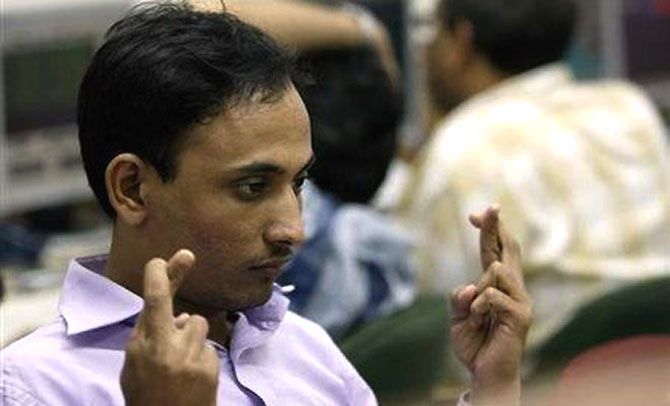 | « Back to article | Print this article |
Eight Sensex biggies such as Reliance, L&T, BHEL, SBI and ICICI Bank are among the worst hit.
 The benchmark indices touched a new lifetime high early last year and were up nearly 20 per cent from the highs of 2008, but over two-thirds of the BSE 500 companies, by market cap, are still in the red, compared to their stock prices in January 2008.
The benchmark indices touched a new lifetime high early last year and were up nearly 20 per cent from the highs of 2008, but over two-thirds of the BSE 500 companies, by market cap, are still in the red, compared to their stock prices in January 2008.
This includes eight Sensex biggies such as Reliance, L&T, BHEL, SBI and ICICI Bank.
As of Thursday’s close, stock prices of 147 out of 425 BSE 500 companies in our sample were below their January 8, 2008 level, when the benchmark Sensex had peaked before the Lehman Crisis.
These companies accounted for 72.5 per cent of the sample market capitalisation in January 2008. Their value share is now down to 27.6 per cent.
What’s more unsettling is the fact that 20 per cent of the companies have lost more than half of their market value in the last eight years.
These companies together accounted for 40 per cent of BSE 500 companies’ combined market cap in January 2008. Their value share is now down to 6.3 per cent, making them marginal players on Dalal Street.
In other words, post-Lehman recovery on Dalal Street was led by companies that were minnows during the 2003-08 boom and many ‘boom-tigers’ never recovered from the 2008 global financial crisis.
The funnel is getting narrower with each passing year as the number of companies with positive earnings declines. It is a red flag for retail investors who enter the market during bull runs.

Some of the top wealth destroyers, with price erosion of more than 90 per cent, have been Unitech, MMTC, JP Associates, Suzlon Energy, JP Power Ventures, Punj Lloyd, HDIL, Indiabulls Real Estate, GVK Power Infrastructure, Hindustan Copper, DLF and Reliance Communications.
“In 2007-08, a lot of fad companies rode the bull market without earnings support. For instance, there was a mad dash to buy realty firms that were hoarding large land banks,” said Raamdeo Agrawal, co-founder, Motilal Oswal Financial Services.
“Investors ignored the fundamentals and were clearly misled by momentum.”
It’s not that only mid-and small caps have suffered. Several Sensex biggies are still in the red zone.
For instance, Reliance Industries, which beat the Sensex in calendar year 2015 after a gap of seven years, still trades 33 per cent below its January 2008 price. SBI, the country’s largest lender, is still quoting 10 per cent below its 2008 price.
“There is a notion that large caps do not see capital erosion in the long term. However, the last few years have proved, that may not necessarily be true. Investors should look at the management, balance sheet quality and the sectoral prospects of the company rather than the mere size,” said G Chokkalingam, founder, Equinomics Research & Advisory.
“Our wealth creation studies suggest there’s merit in investing in mid-and small caps. However, they are prone to high mortality, whereas large caps stand for stability. So, portfolios with a healthy mix of the two should be an ideal strategy for investors,” said Agrawal.
In the last eight years, the Sensex has risen 19 per cent, while the broader BSE MidCap index is up 10.5 per cent. The BSE SmallCap index, on the other hand, has shed 14.9 per cent in the same period.
Sectors such as infrastructure and real estate prominently feature in the list of wealth destroyers. The share prices of realty majors such as Unitech, Indiabulls Real Estate and DLF have eroded by more than 90 per cent.
Commodity firms have also been under the weather as volatile prices during the last eight years have taken a toll.
The last year has been particularly tough with commodity prices dipping by 70-80 per cent and oil prices touching 11-year lows. Firms such as MMTC, Vedanta, Hindustan Copper, Tata Steel, Bhushan Steel and Jindal Steel & Power have slipped anywhere between 56 per cent and 97 per cent.
Quite a few public sector firms — including SAIL, MTNL, MMTC, Indian Overseas Bank, Bank of India, Nalco and BHEL — have also been wealth destroyers.
In the last eight years, the Sensex has risen 19 per cent, while the broader BSE MidCap index is up 10.5 per cent. The BSE SmallCap index, on the other hand, has shed 14.9 per cent in the same period.
Indian equities enjoyed a sustained bull run between 2003 and 2008, led by infra and real estate stocks.
The benchmark indices consistently made new highs before tumbling more than seven per cent on January 21 on account of global financial crisis and a recession in the US.